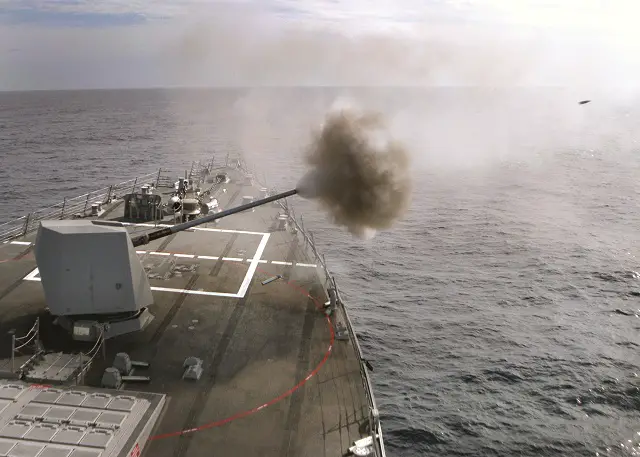Breaking news
Industry Advances Long Range, Precision Munitions (by: BAE Systems).
| 2015
 BAE Systems Hyper Velocity Projectile (HVP) 5 inch variant |
|||
In
the last year, the Navy and other government agencies have actively solicited
information to learn more about industry advancements and the potential
for increased capabilities. One such example is the Navy’s 2014
request for information (RFI) to seek industry capabilities for a long-range
precision guided 5-inch ammunition. Another example is the Defense Advanced
Research Projects Agency (DARPA) issuing of a Broad Agency Announcement
to seek possible solutions to improve the effectiveness of smaller caliber
guns and ammunition against anti-ship missiles. In addition to information solicitations, the Navy has also funded the development of a long-range precision munition, the Hyper Velocity Projectile (HVP), as part of the development of the Electromagnetic Railgun. While ultimately intended for the future Electromagnetic Railgun in a version that will use only kinetic energy to generate lethality, HVP is being designed to support multiple platforms, including the Navy’s 5- and 6-inch gun systems with a version that will include a warhead. |
|||
 The BAE Systems Mk45 Mod 4 main gun is being fitted on all new-built (or upgraded) US Navy destroyers and cruisers |
|||
The
funded programs for long-range precision ammunition and the Navy’s
recent information requests reflect growing interest in munitions that
increase current ranges, address static and moving targets, procure relatively
mature solutions, and minimize changes to in-place gun systems. The RFI issued in 2014 demonstrates such interest to enhance the capability of the Mk45 Mod4 guns on the Navy’s Destroyers and Cruisers. During the Mk45’s long history, improvements have been made in ammunition handling, digitization and incremental range improvements, but the gun’s range is limited to 13 nautical miles and fires unguided ammunition. |
|||
 BAE Systems' Multi Service - Standard Guided Projectile (MS-SGP) |
|||
BAE
Systems is pursuing two unique and complimentary solutions to address
these shortfalls. – the Multi
Service - Standard Guided Projectile (MS-SGP) and the HVP
– both of which will nearly quadruple current range options when
fired from a Mk45 Mod 4 gun. The MS-SGP is designed to achieve a range
of up to 54 nautical miles and the HVP 5-inch variant 50. Both are designed
for a high degree of accuracy. While both are capable of addressing multiple
mission sets, their optimal capabilities differ. Upgrades of this natureare
significant because they would give the Navy a more cost-effective and
target-appropriate option for land attack missionswhich Cruisers and Destroyers
are called upon to support, as well surface threats at longer ranges and
air threats. The Navy’s operations in Libya in 2011 are a prime illustration of the cost-savings comparisons between conventional missiles and long-range and precision gun-launched projectiles. In the first few days of operations, the U.S. and U.K. navies launched more than 160 Tomahawk missiles. The cost of this operation was close to a quarter billion dollars. While the Tomahawks were certainly effective in knocking out the enemy, if the Navy had available a 5-inch gun with affordable, long-range precision munitions, it likely could have addressed many these targets for drastically less cost. Using the figures in the Navy’s 2014 RFI, solutions were sought costing less than $55,000 per round. Had such an option been available in Libya, taxpayers could have saved hundreds of millions of dollars. While the Navy takes steps to fulfil the promise of the recently announced Third Offset Strategy, it should also take cost-effective, near-term steps to leverage industry investments and recent technology improvements with ammunition. Doing so would improve its ability to address today’s threats on the right side of the cost curve and soon. Visit BAE Systems during Sea-Air-Space 2015 on booth #2439 |
|||



























